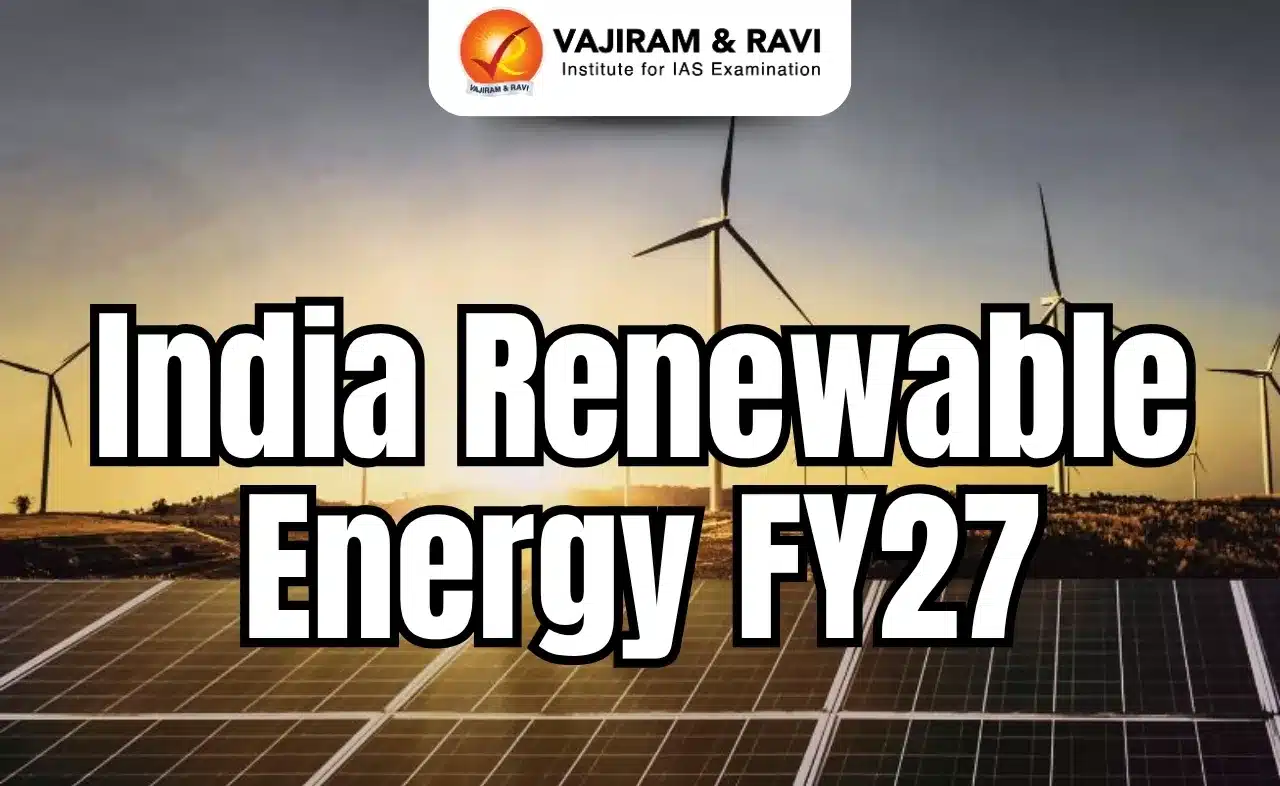India Renewable Energy FY27 Latest News
- India is projected to add 75 GW of renewable energy in FY26 and FY27—a 53% rise from the 49 GW added in FY24–25, according to Crisil Ratings.
- Investments are expected to grow by 52%, from ₹2.5 lakh crore to ₹3.8 lakh crore, driven by a rising share of capital-intensive hybrid projects. However, Crisil warns that delays in transmission infrastructure could hinder future capacity expansion.
Renewable Energy in India
- As of October 10, 2024, India’s total renewable energy capacity has reached 201.45 GW, marking a major milestone in its clean energy journey.
- This achievement highlights India’s commitment to reducing fossil fuel dependence and building a sustainable energy future.
Non-Fossil Fuel Sources Powering Nearly Half of India
- Including the 8,180 MW of nuclear capacity, India’s total non-fossil fuel-based power now makes up nearly 50% of its installed electricity generation capacity, positioning the country as a global leader in clean energy.
Renewables Dominate India’s Energy Mix
- India’s total electricity generation capacity stands at 452.69 GW, with renewables contributing 46.3% of this.
- The renewable segment is supported by a diverse mix of sources:
- Solar Power: 90.76 GW
- Wind Power: 47.36 GW
- Large Hydroelectric Power: 46.92 GW
- Small Hydro Power: 5.07 GW
- Biopower (biomass and biogas): 11.32 GW
India’s 2030 Renewable Energy Target
- The Government of India has set an ambitious goal of achieving 500 GW of installed non-fossil fuel electric capacity by 2030, aiming to bolster energy security and address climate change.
Flagship Renewable Energy Schemes
- National Green Hydrogen Mission: Promotes production and use of green hydrogen.
- PM-KUSUM: Supports solar power for agriculture.
- PM Surya Ghar: Encourages rooftop solar adoption for households.
- PLI Scheme for Solar PV Modules: Boosts domestic manufacturing of solar equipment.
Investment Facilitation
- 100% FDI allowed under the automatic route for renewable energy.
- Project Development Cell established to ease investment processes.
Infrastructure Development
- Ultra Mega Renewable Energy Parks to provide land and transmission.
- Transmission plan till 2030 in place for grid readiness.
- Green Energy Open Access Rules 2022 to ease access for renewable power buyers.
Offshore and Wind Energy Initiatives
- Offshore Wind Strategy: Targets 37 GW bidding by 2030.
- Offshore Wind Lease Rules, 2023: Regulates leasing for project development.
- National Repowering Policy 2023: Modernizes old wind turbines.
Massive Renewable Energy Expansion Planned
- India is expected to add 75 GW of renewable energy capacity in FY26 and FY27, a 53% increase from 49 GW added in FY24–25, according to Crisil Ratings.
- This will raise the country’s total renewable capacity to 233 GW by March 2027.
Investment to Surge by 52%
- Investments in the renewables sector are projected to grow from ₹2.5 lakh crore in FY24–25 to ₹3.8 lakh crore in FY26–27—a 52% jump.
- This surge is driven by the increasing share of capital-intensive hybrid and storage-linked projects.
Rise of Hybrid and Storage-Linked Projects
- Around 37% of the upcoming 75 GW capacity will come from hybrid and storage-linked projects—up from 17% in FY24–25.
- Hybrid projects combine solar and wind to ensure more consistent power generation, while storage-linked projects use batteries or pumped hydro to store excess energy.
- As renewable power is intermittent—solar during the day and wind being seasonal—increasing its share can disrupt grid stability.
- Hybrid and storage solutions help maintain round-the-clock power supply and grid balance.
Transmission Infrastructure a Key Bottleneck
- Transmission remains a major challenge.
- Though capex in this sector rose to ₹36,000 crore in FY25 (up from ₹15,000 crore in FY24), the Crisil report warns of delays due to equipment supply constraints and execution bottlenecks.
- FY26–27 transmission capex is projected to reach ₹0.9–1 lakh crore.
Slow Progress in Power Purchase Agreements (PPA)
- Only 50% of PPAs for projects awarded in the last 1–2 years have been finalized, due to limited interest from state discoms.
- However, this is expected to improve as power demand and renewable purchase obligations grow.
Capacity Addition Planned in FY26
- As per a recent Grid-India resource adequacy report, the country will add 45 GW in the ongoing FY26, led by:
- Solar: 26.5 GW
- Wind: 6.3 GW
- Coal: 4.4 GW
- Battery Storage: 3.3 GW
- Hydro: 1.6 GW
- Pumped Storage: 1.5 GW
- Nuclear: 1.4 GW
India Renewable Energy FY27 FAQs
Q1. How much renewable energy will India add by FY27?
Ans. India will add 75 GW of renewable capacity during FY26 and FY27, a 53% rise from previous two years.
Q2. What is driving investment growth in renewables?
Ans. The rising share of hybrid and storage-linked projects, which are more capital intensive, is pushing up investments.
Q3. What is India’s total renewable capacity as of 2024?
Ans. As of October 2024, India’s renewable energy capacity reached 201.45 GW, or 46.3% of total generation capacity.
Q4. What challenges could affect capacity addition?
Ans. Delays in expanding transmission infrastructure and limited progress in finalizing Power Purchase Agreements (PPAs) are major hurdles.
Q5. What are key renewable energy sources in India?
Ans. India’s mix includes solar (90.76 GW), wind (47.36 GW), hydro (51.99 GW), and biopower (11.32 GW).
Last updated on December, 2025
→ Check out the latest UPSC Syllabus 2026 here.
→ Join Vajiram & Ravi’s Interview Guidance Programme for expert help to crack your final UPSC stage.
→ UPSC Mains Result 2025 is now out.
→ UPSC Notification 2026 is scheduled to be released on January 14, 2026.
→ UPSC Calendar 2026 is released on 15th May, 2025.
→ The UPSC Vacancy 2025 were released 1129, out of which 979 were for UPSC CSE and remaining 150 are for UPSC IFoS.
→ UPSC Prelims 2026 will be conducted on 24th May, 2026 & UPSC Mains 2026 will be conducted on 21st August 2026.
→ The UPSC Selection Process is of 3 stages-Prelims, Mains and Interview.
→ UPSC Result 2024 is released with latest UPSC Marksheet 2024. Check Now!
→ UPSC Prelims Result 2025 is out now for the CSE held on 25 May 2025.
→ UPSC Toppers List 2024 is released now. Shakti Dubey is UPSC AIR 1 2024 Topper.
→ UPSC Prelims Question Paper 2025 and Unofficial Prelims Answer Key 2025 are available now.
→ UPSC Mains Question Paper 2025 is out for Essay, GS 1, 2, 3 & GS 4.
→ UPSC Mains Indian Language Question Paper 2025 is now out.
→ UPSC Mains Optional Question Paper 2025 is now out.
→ Also check Best IAS Coaching in Delhi

















